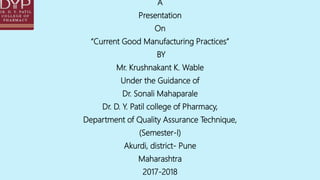cGMP
- 1. A Presentation On âCurrent Good Manufacturing Practicesâ BY Mr. Krushnakant K. Wable Under the Guidance of Dr. Sonali Mahaparale Dr. D. Y. Patil college of Pharmacy, Department of Quality Assurance Technique, (Semester-I) Akurdi, district- Pune Maharashtra 2017-2018
- 2. Contents- ï Introduction ï Definition ï Components of cGMP ï Areas to be covered ï Conclusion ï References 2
- 3. INTRODUCTION ï cGMP refers to Current Good Manufacturing Practices regulation enforced by US FDA. ï cGMP provides system that assures proper design, monitoring and control on manufacturing process and facilities. ï cGMP regulation assure the identity, strength, quality and purity of drug product by requiring that manufacturer of medication adequately control manufacturing operations. ï This includes establishing strong Quality Management System, obtaining appropriate quality of raw material, detecting and investigating product quality deviations and maintaining reliable testing laboratories. 3
- 4. ï cGMP adequately put into practice to prevent instance of contaminations, mix- ups, failure and error. ï These assures product meet their quality standard. ï Definition of cGMP as per WHO : GMP is the part of QA which assure that the product are consistently produced and controlled to the quality standards appropriate to their intended use as required by marketing authorization. 4
- 5. Components of cGMP: a. GMP is a part of QA . b. Main function of GMP is to produce quality product consistently. c. GMP must meet both production and QA related issues. d. GMP must meet legal requirements of country. e. GMP further comments that main function of GMP is avoid mix-ups and contamination. 5
- 6. cGMP covers : ï General consideration ï Personnel ï Premises ï Equipmentâs ï Sanitization ï SOPâs ï Raw material ï Self inspection and audits ï Master formula records ï Batch manufacturing records ï Warehousing area ï Labels and other printed material ï QA 6
- 7. General consideration: ï Compliance with GMP. ï Consistent uniform batches. ï Location and surrounding. ï Water system. ï Disposal of waste. 7
- 8. Personnel: ï Qualified person: ï§ Experience ï§ Sufficient number ï Written job description. ï Trained . ï Health: ï§ Disease. ï§ Open lesion. ï§ Skin disease . ï§ Allergic reaction. 8
- 9. Premises: 9
- 10. Point to be considered: Location: Geography, climate, economical factor, neighbourers Premises must be located to minimize the risk of cross contamination. e.g. Not located next to Malting Factory with high airborne level of yeast. Design: ï Maintain risk of errors. ï Permit effective cleaning. ï Permit effective maintenance. ï Avoid cross contamination. ï Maximum protection against entry of insect, birds, animals. ï Separate facilities for other products like antibiotics, hormones, cytotoxic substances.10
- 11. Hygiene and sanitization: ï Eating, drinking, smoking should not be allowed in production area. 1. Design and construction . 2. Ventilation, air filtration, air handling and cooling. 3. Lightening. 4. Plumbing. 5. Sewage and refuse. 6. Washing and toilet facilities . 7. Sanitization. 8. Maintenance. 11
- 12. Equipment's: 12
- 13. ï Equipment's shall be located, design and constructed to suit the operation to be carried out. ï Should be made up of non reactive material. ï Equipment's should be- a. calibrated . b. Checked . c. Labelled. d. Sterilized. e. Accompanied with SOP. 13
- 14. Standard Operating Procedure (SOPâs): There shall be SOPâs for each operation . a. For equipment. b. For sampling. c. For testing. d. For processes. e. For packaging. 14
- 15. Raw material : ï Inventory should be maintained for raw material to be used at any stage of manufacturing. ï Record should be maintained as per schedule U. ï Purchased from approved source. ï Must checked by QC department. ï Should be labelled. 15
- 16. Self Audit and Inspection: ï Regular independent inspection is necessary to evaluate the manufacturerâs compliance with GMP in all aspects of manufacturing. ï Procedure for self inspection shall be documented including: ï§ Evaluation. ï§ Conclusion. ï§ Recommendation for corrective action. ï There should be Batch Manufacturing Record (BMR) and Master formulation record(MFR). 16
- 17. 17
- 18. Packaging And Labelling Control: 1. Material examination and usage criteria: ï Record shall be maintained for each different labelling and packaging material, indicating receipt, examination tests whether accepted or rejected. ï Labels and labelling material for different drug products, strength, dosage form shall be stored separately with suitable identification. 2. Packaging and labelling operation : ï Should examine for suitability and correctness. ï Should be documented in batch production record. 18
- 20. The conditions satisfied by the warehousing area are as follows: ï Good storage condition. ï Clean and dry. ï Acceptable temperature limit. ï Good sanitization. ï Separate Sampling area. ï Fire prevention. ï Properly labelled material. 20
- 21. GMP is good common sense Quality Management Quality Assurance GMP Production and Quality Control 21
- 22. Quality Assurance: ï Main objective of QA is to ensure the products are of quality required for there intended use . Functions: ï Adequate are made for manufacturing, supply and use of correct starting and packaging material. ï Adequate control on starting material, intermediate and bulk product. ï Process of validation in accordance with established procedures. 22
- 23. Conclusion: ï GMP compliance is not an option. ï Quality should build into the product. ï GMP are very similar and really good common sense. ï Good practices covers all aspects of manufacturing activities prier to supply. ï The role and involvement of senior is crucial. 23
- 24. References : ï Manohar A Potdar âPharmaceutical Quality Assuranceâ Nirali prakashan , Third edition , page no. 5.10-5.11 ï Pharmaceutical press âRules and guidance for pharmaceutical manufacturer and distributors- Edition 2007â 24
- 25. Thank youâĶ. 25
























